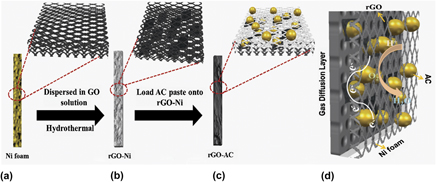Crossref Citations
This article has been cited by the following publications. This list is generated based on data provided by
Crossref.
Massaglia, Giulia
Margaria, Valentina
Sacco, Adriano
Castellino, Micaela
Chiodoni, Angelica
Pirri, Fabrizio C.
and
Quaglio, Marzia
2019.
N-doped carbon nanofibers as catalyst layer at cathode in single chamber Microbial Fuel Cells.
International Journal of Hydrogen Energy,
Vol. 44,
Issue. 9,
p.
4442.
Shahbazi Farahani, Fatemeh
Mecheri, Barbara
Majidi, Mir Reza
Placidi, Ernesto
and
D'Epifanio, Alessandra
2019.
Carbon-supported Fe/Mn-based perovskite-type oxides boost oxygen reduction in bioelectrochemical systems.
Carbon,
Vol. 145,
Issue. ,
p.
716.
Mahalingam, Shanmugam
Ayyaru, Sivasankaran
and
Ahn, Young-Ho
2020.
Enhanced cathode performance of Fe2O3, boron nitride-doped rGO nanosheets for microbial fuel cell applications.
Sustainable Energy & Fuels,
Vol. 4,
Issue. 3,
p.
1454.
Massaglia, Giulia
Sacco, Adriano
Castellino, Micaela
Chiodoni, Angelica
Frascella, Francesca
Bianco, Stefano
Pirri, Candido F.
and
Quaglio, Marzia
2021.
N-doping modification by plasma treatment in polyacrylonitrile derived carbon-based nanofibers for Oxygen Reduction Reaction.
International Journal of Hydrogen Energy,
Vol. 46,
Issue. 26,
p.
13845.
Feng, Yujie
Li, Wen
An, Jingkun
Zhao, Qian
Wang, Xin
Liu, Jia
He, Weihua
and
Li, Nan
2021.
Graphene family for hydrogen peroxide production in electrochemical system.
Science of The Total Environment,
Vol. 769,
Issue. ,
p.
144491.
Mohyudin, Sidra
Farooq, Robina
Jubeen, Farhat
Rasheed, Tahir
Fatima, Masoom
and
Sher, Farooq
2022.
Microbial fuel cells a state-of-the-art technology for wastewater treatment and bioelectricity generation.
Environmental Research,
Vol. 204,
Issue. ,
p.
112387.
Benito-Santiago, Sandra Edith
Gnanaseelan, Natarajan
Guerrero-Contreras, Jesús
Kamaraj, Sathish-Kumar
and
Caballero-Briones, Felipe
2023.
Advanced Nanomaterials and Nanocomposites for Bioelectrochemical Systems.
p.
357.
Wang, Hui
Long, Xizi
Cao, Xian
Li, Lei
Zhang, Jingran
Zhao, Yaqian
Wang, Dongqi
Wang, Zhe
Meng, Haiyu
Dong, Wen
Jiang, Chunbo
Li, Jiake
and
Li, Xianning
2023.
Stimulation of atrazine degradation by activated carbon and cathodic effect in soil microbial fuel cell.
Chemosphere,
Vol. 320,
Issue. ,
p.
138087.
Dhanda, Anil
Thulluru, Lakshmi Pathi
Raj, Rishabh
Bhar, Rajarshi
Chowdhury, Shamik
Kuila, Saikat Kumar
Dubey, Brajesh K.
and
Ghangrekar, Makarand M.
2025.
Catalysing holistic wastewater treatment, electricity generation, and emerging contaminant removal in a pre-pilot Fenton-microbial fuel cell.
Journal of Materials Chemistry A,
Vol. 13,
Issue. 12,
p.
8385.
Tran, Huong V.H.
Koo, Bonyoung
Son, Sunghoon
Chai, Hyungwon
Park, Sena
Im, Huisu
and
Jung, Sokhee P.
2025.
Assessment of several carbon-based materials as cathode amendment on stimulating oxygen reduction reaction catalytic in microbial fuel cells.
Journal of Water Process Engineering,
Vol. 73,
Issue. ,
p.
107665.
